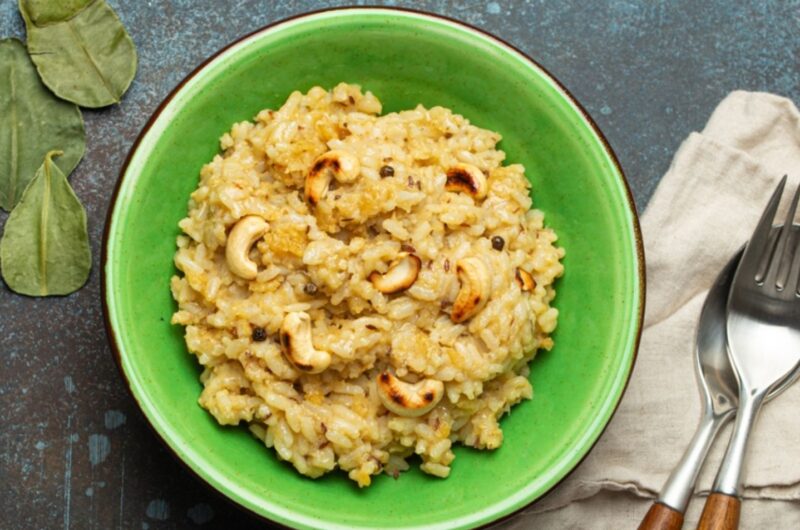Pongal Recipe: A Comforting South Indian Dish
Recipe by Healthy BiteCuisine: Indian, South Indian10 minutes
20 minutes
250
1 bowl
33g
Pongal is a classic South Indian dish made with rice, moong dal (yellow lentils), and aromatic spices. It’s a comforting, easy-to-digest meal often served as breakfast or during festivals like Pongal. Ven Pongal (savory Pongal) is rich in flavor, thanks to the addition of ghee, black pepper, and cumin. Let’s dive into this simple yet delicious recipe and explore dietary advice to make it even healthier!
Ingredients
1/2 cup rice (short-grain or raw rice)
1/4 cup yellow moong dal (split yellow lentils)
2 1/2 cups water
1/2 teaspoon turmeric powder (optional)
Salt to taste
2 tablespoons ghee (or oil for a vegan option)
1 teaspoon cumin seeds
1 teaspoon black pepper (coarsely crushed)
1-inch ginger, grated
8-10 curry leaves
8-10 cashews (optional, for garnish)
A pinch of asafoetida (hing)
Directions
Cooking the Rice and Dal:
- Rinse and Soak: Wash the rice and moong dal thoroughly. Soak them together for 15-20 minutes.
- Cook the Mixture: In a pressure cooker or pot, add the soaked rice and dal, water, turmeric powder (if using), and salt. Cook until soft and mushy (3-4 whistles in a pressure cooker or about 20 minutes in a pot). Mash lightly for a creamy consistency.
Preparing the Tempering:
- Heat Ghee: In a small pan, heat ghee. Add cumin seeds and let them splutter.
- Add Spices: Add black pepper, grated ginger, curry leaves, and asafoetida. Sauté for a minute until aromatic.
- Add Cashews: Toss in the cashews and roast until golden brown.
Combining:
- Mix the Tempering: Pour the tempering over the cooked rice and dal mixture. Mix well.
- Serve Hot: Serve Ven Pongal hot with coconut chutney, sambar, or a dollop of ghee on top.
Tips & Variations
- Healthier Option: Use whole wheat semolina or millet instead of regular semolina for added fiber and nutrients.
- Vegan Option: Use coconut oil instead of ghee for a vegan-friendly version.
- Add Protein: Include roasted peanuts or tofu cubes for a protein boost.
- Spice Level: Adjust the number of green chilies to suit your spice preference.
- Serving Suggestions: Pair Upma with coconut chutney, tomato chutney, or a dollop of yogurt for a complete meal.
Dietary Advice
- Upma is a healthy and versatile dish, but here’s how to make it even more diet-friendly:
- Low-Calorie Option:
Use minimal oil or ghee while cooking to reduce the calorie content. Stick to 1 serving (1 bowl) for a balanced meal. - High-Fiber Version:
Add more vegetables like spinach, zucchini, or broccoli to increase the fiber content, which aids digestion and keeps you full longer. - For Diabetics:
Replace semolina with low-glycemic grains like millet or quinoa to manage blood sugar levels. Pair Upma with a protein-rich side like yogurt or boiled eggs. - For Weight Watchers:
Use whole wheat semolina or broken wheat (dalia) instead of regular semolina. Avoid adding too much oil or ghee. - For Gluten-Free Diets:
Replace semolina with gluten-free grains like rice flour, cornmeal, or millet to make a gluten-free version of Upma. - Protein Boost:
Add roasted peanuts, tofu, or paneer cubes to increase the protein content, making it a more balanced meal. - Travel-Friendly:
Upma is easy to pack and stays fresh for hours, making it a great option for lunchboxes or travel snacks.
- Low-Calorie Option:
